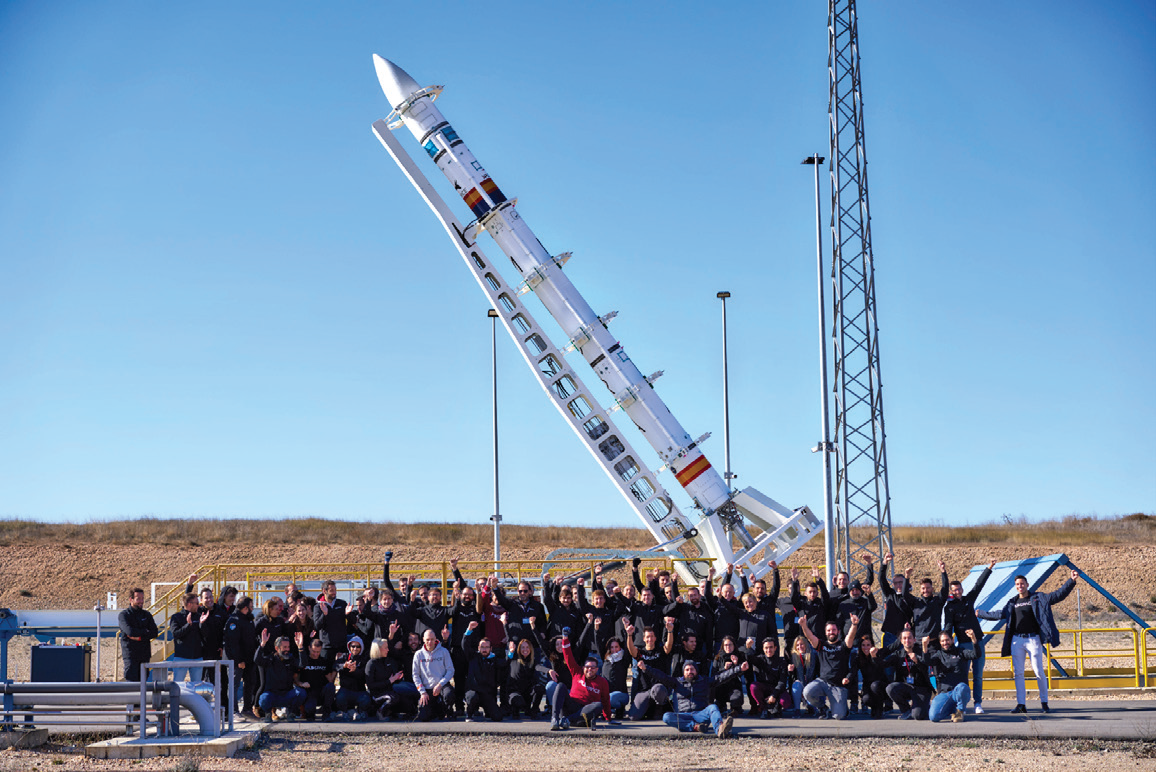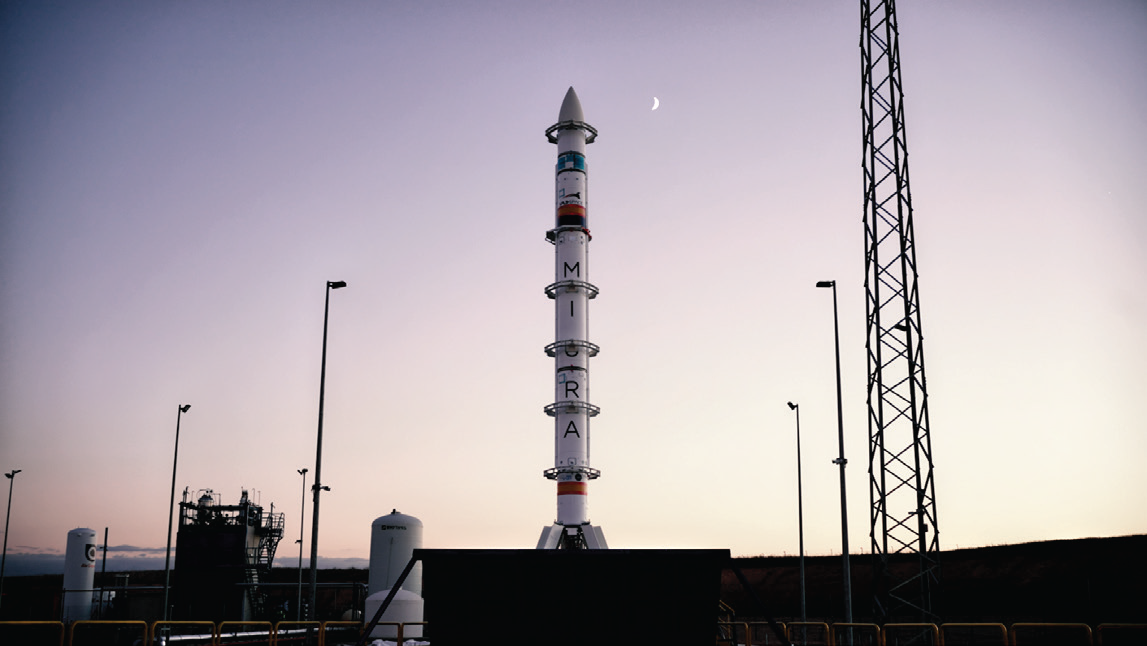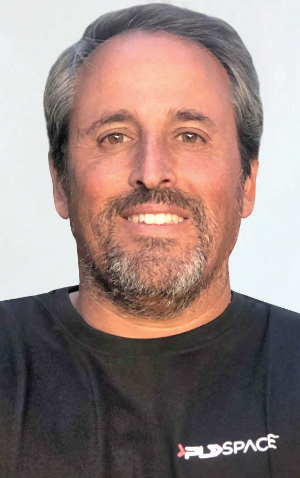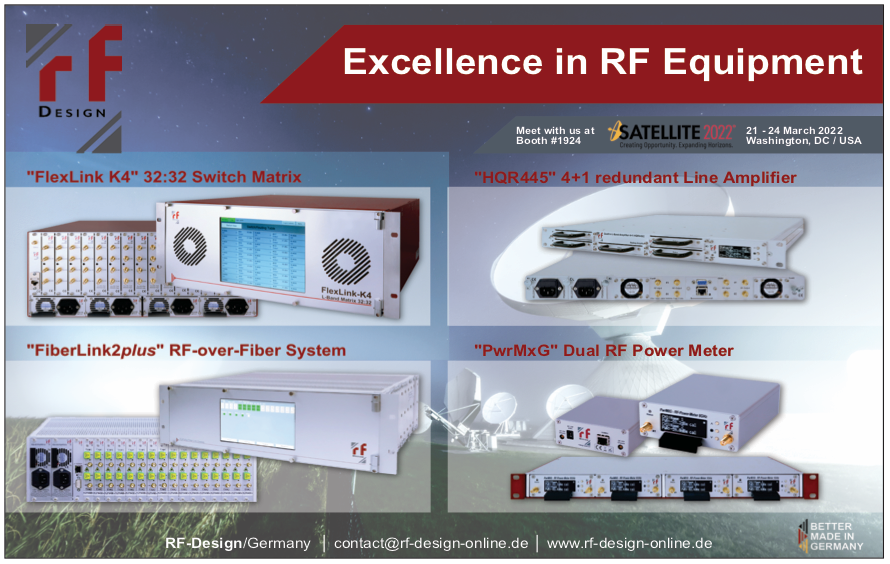PLD Space is a European company with the goal of becoming the European Microlauncher Company, a reference within the sector with reusable rockets dedicated to the launch of smallsats. For this, PLD Space is developing two, reusable launch vehicles named MIURA 1 and MIURA 5.

The PLD Space team.
MIURA 1 was conceived as a one-stage suborbital sounding rocket that uses a liquid propulsion system fully designed and built by PLD Space — MIURA 5 is a two-stages launch vehicle for smallsats with that incorporates in-house propulsion, structures and avionics development. The company has also developed its own engine, TEPTREL-B, which, in 2021, became the first KeroLOX rocket engine developed in Europe qualified for space flight. Founded in 2011, the firm recently achieved a new milestone with the official presentation of MIURA 1, which was exhibited fully assembled for the first time in the National Museum of Natural Science in Madrid. More than 10,000 people could see the rocket and learn about the work at PLD Space during a entire weekend late last year.
Next steps before MIURA 1 launch
MIURA 1 has returned to the PLD Space base at Teruel Airport to carry out combined qualification testing at stage level, including full-mission duration hot test of the complete stage. After these tests, the stage will be shipped to the launch base to perform a combined test campaign with all the ground segment and ground infrastructure before launch. MIURA 1 is propelled by a single regeneratively cooled TEPREL-B liquid engine powered by liquid oxygen and kerosene. The recovery system on board MIURA 1 can safely return the whole launch vehicle to ground, enabling the payloads to be returned to the customers and the complete rocket to be used again. After re-entry, two parachutes are deployed consecutively. The Payload Bay of the MIURA 1 launch vehicle is composed of up to four, standardized, payload compartments which are situated directly underneath the nosecone. Each payload compartment can hold a payload mass of up to 25 kg.
Launch From Spain
The MIURA 1 launch is expected to occur during the second half of 2022, which will be the first launch mission of a European rocket in history, designed to reach a maximum altitude of 150 km. and with the capacity to carry a payload of up to 100 kg. This maiden flight is set to take place from the historical Spanish launch site “El Arenosillo” (Huelva) in the south-west of Spain. From there, the rocket will fly into a south-westerly direction and after a flight time of about 12.5 minutes, splash down about 70 km. off the coast in the Gulf of Cádiz in the Atlantic Ocean. In this first test flight, MIURA 1 will carry several payloads. Half of the total available payload capacity will be used by PLD Space. A variety of sensors will be integrated into the rocket with the intention to quantify the flight environment. The other half of the available payload mass has been opened for the scientific community and will house several scientific experiments.
The Ultimate Goal
With the MIURA 1 launch vehicle, PLD Space will serve the suborbital market by providing frequent flight access and serves as a technology demonstrator for MIURA 5. In fact, the company is already working on its first MIURA 5 reusable orbital rocket, which is expected to be ready to carry out its first mission in July of 2024, and which will mark the start of the firm’s commercial satellite launches.

MIURA 5 maiden flight will have a capacity of 450 kg. of payload mass to LEO orbit from Guiana Space Center, CSG, Europe´s Spaceport in French Guiana. The first launch vehicle to fly will be MIURA 5 block 1.0, a fully expendable version that will make the first two launches. After those flights, the company will introduce a reusable version for subsequent flights, paving the way for a commercial reusable booster in Europe. This stage will implement all of the lessons learned from ESA´s Future Launchers Preparatory Program (FLPP) contracts, called Liquid Propulsion Stage Recovery (LPSR) 1 and LPSR2. Two drop tests have been performed successfully to verify the parachute design and recovery operations. The first drop test was performed in Eloy, Arizona, in February of 2019. A mass dummy was equipped with the MIURA 1 parachute system and dropped from an airplane. The test successfully verified the proper functioning of the drogue and main parachute, but also the design of the parachute canister, proper hatch ejection and correct functioning of parachute deployment triggers.
A second drop test was performed in April of 2019 from INTA´s “El Arenosillo” launch site in Spain, in the framework of ESA´s FLPP Program. A mock-up of the first stage of the MIURA 5 was dropped from a Chinook-CH47 helicopter into the Atlantic Ocean. Even though the used parachute system was scaled for MIURA 5, the subsystems controlling the deployment are identical to the ones used on MIURA 1. This drop test was also used to test parts of the ground segment that is used for the MIURA 1 launches. Additionally, it provided PLD Space with an excellent opportunity to understand and train the procedures for the MIURA 1 sea recovery. Following the successful results of the drop test of the first stage of the MIURA 5, ESA awarded a new contract in 2021 to PLD Space. The project by PLD Space and the European Space Agency (LPSR2) is a continuation of the previous contract awarded by ESA to PLD Space in 2017 and executed between 2017 to 2019. This contract is part of ESA’s Future Launchers Program and focuses on the study of re-entry trajectories and configurations for the safe descent of stage one of MIURA 5.
A Growing Company
The firm is based in Elche (Alicante, Spain) and has technical facilities in Teruel, Huelva and French Guiana. The headquarters also houses the rocket factory, where MIURA 1 and MIURA 5 are being manufactured. More than 80 people are currently working on the ambitious mission of providing access to space using reusable launch vehicles, but the team is growing and growing. In fact, the firm expects to increase its workforce up to 200 employees in 2022 and triple its size in the next three years. This sustainable growth is possible thanks to the support of PLD Space investors. Last December, the company closed a Series B Funding round of $28 million, which brings the total capital raised to more than $50 million. The company, based in Elche (Alicante), has maintained the interest of both private investors and public institutions. With this level of follow-on, PLD Space financial viability is guaranteed to undertake their next milestones such as the first commercial launch of MIURA 5, the internalization of a good part of the rocket production processes and the demonstration flights of MIURA 1.
www.pldspace.com

Pablo Gallego Sanmiguel is PLD Space Senior Vice President, Sales & Customers. Before joining PLD Space in 2019, he developed his professional career from California (United States) working as Mission Manager of Launching Services with SpaceX as well as providing aerospace consulting services. Previously, Pablo had participated actively in several other rocket launch operations, such as Ariane 4, Ariane 5, Soyuz, Dnepr, Vega, Falcon 9 and Falcon Heavy. Currently, Pablo coordinates his activities in PLD Space between the United States and Europe where he directly addresses the needs of customers.



